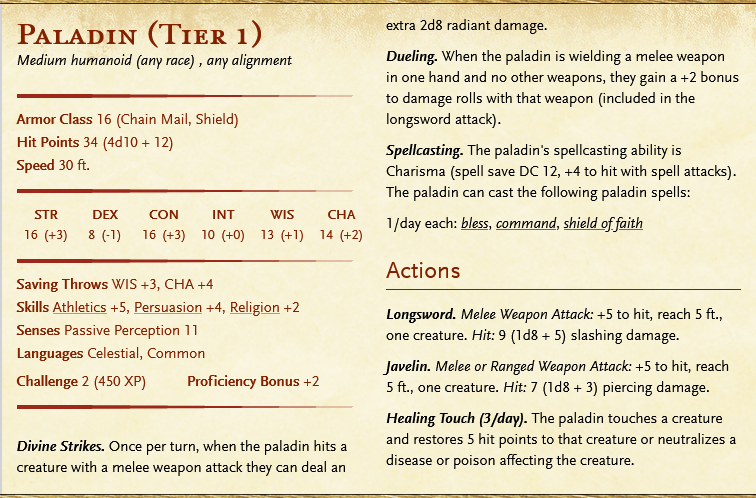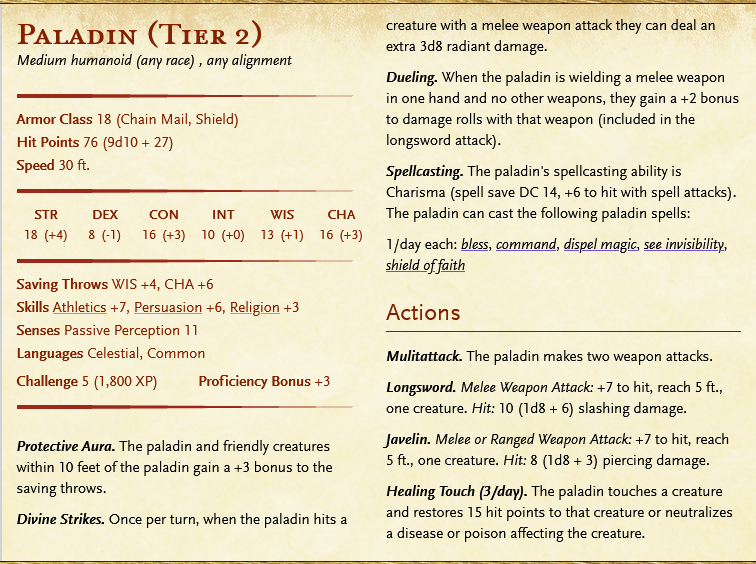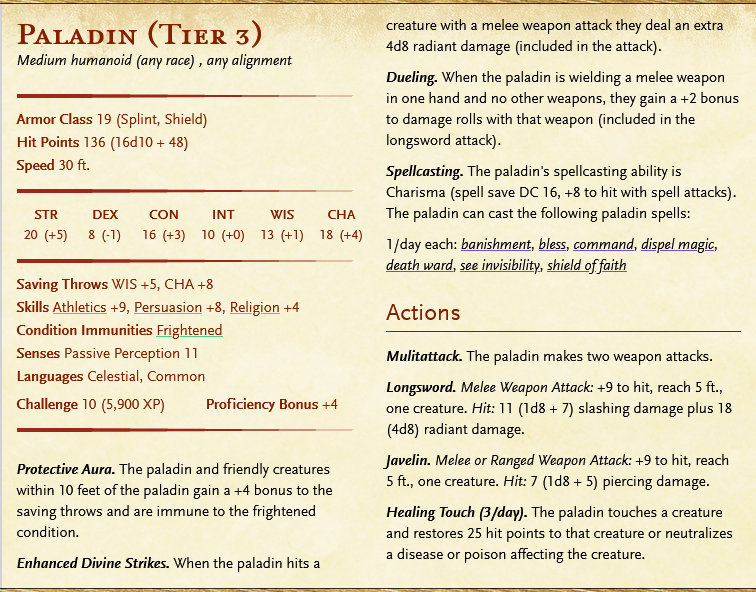Paladin NPCs & How to Use Them for EVERY Tier of Play
When we create something new, our natural instincts are to lean on what we know. This sort of adaptive thinking is a great place to start, but oftentimes it leads to future problems and inefficiencies.
Case in point, how many of you have made NPCs for your game as if you were making a new player character? If you need an NPC to act as the party's guide through an unmapped forest, your gut instinct might be to make a ranger. If the party wants to meet with a well-known religious figure, well then that’s a cleric. These instincts aren’t wrong, it’s easier for you and your players when certain figures match a well-known/understood archetype. BUT, by treating your NPCs as player characters you open yourself up to future headaches. You don’t need a three page character sheet to run a good ally, villain, or quest giver and you don’t need to agonize over every detail like you might for a PC that will be in the game for months on end.
With that in mind, over the course of this series we’ll be putting together NPC statblocks based on character class levels for each of the four tiers of play. In Fifth Edition, the four tiers of play are designed as a guidepost for how well-known your party should be and what types of threats they will most often face.
Those four tiers are:
Local Heroes (Levels 1-4)
Heroes of the Realm (Levels 5-10)
Masters of the Realm (Level 11-16)
Masters of the World (Levels 17-20)
For each of these tiers, we’ll be making an NPC statblock that has the basic abilities and stats of a player character of that same class and tier. A quest giver or political ally may be a tier above the party and serve as their “gateway” into those more high stakes problems and adventures. A hireling, such as a mercenary or wilderness guide, may be in a lower tier compared to the party.
With all that setup out of the way, let's dive right into our first set of NPCs! For this article, we’ll be making NPCs based off of the paladin class.
Tier 1 Paladins
Tier 1 paladins are mostly likely to be encountered by player characters between levels 1 and 4, although they may crop up as allies or henchpeople of more powerful beings at later levels. Tier 1 paladins are probably in a similar situation as a low-level party- they are relatively unknown and looking to make their mark. Such paladins may have been sent out by their church/organization to investigate a rising evil, or may have sworn an Oath of Vengeance after a band of marauders attacked their village and now they seek revenge.
Customizing an NPC. To customize a paladin of this tier, you can do one or more of the following:
Add a Channel Divinity option from one of the paladin oath subclasses for player characters.
Swap out one or more of their spells with the oath spells from a paladin subclass.
Plot Hooks/Use in Your Game. While it is not necessary to assign a NPC with an oath/subclass, it can sometimes be helpful to view an NPCs role in your world through that lens. Paladins are far more than just lawful-stupid champions of good and the multitude of different oaths are a testament to that. Although, there is nothing wrong with a classic lawful good/Oath of Devotion paladin!
A nearby church or faction sent a scout to investigate some unnatural disturbances. It has been several weeks and they have not yet returned. The party is tasked with finding the paladin and assisting them in their mission, should they still be alive. (Oath of Devotion).
The paladin seeks admission into a secret or exclusive order, but must find a way to prove themselves. They are seeking companions for a dangerous quest to slay a great evil. (Oath of Glory).
A fellow traveler approaches the party and begins questioning them regarding a group of roving bandits or marauders. The traveler seeks to enact their vengeance on the bandit leader and offers the party a family heirloom or some other reward in exchange for their aid. (Oath of Vengeance).
A band of well-equipped soldiers have taken over a small town. They are led by a young paladin seeking to establish a domain of security and iron-clad rule. (Oath of Conquest).
Tier 2 Paladins
Tier 2 paladins are most likely to be encountered by PCs from levels 5 to 10, although you may insert them earlier as a potential patron or mentor figure. They may be used at later levels as allies or lieutenants of even more powerful creatures. At tier 2, these paladins could be leaders of religious groups in notable cities, members of secret organizations, or serve as protectors to the nobility and other prominent members of society.
Customizing an NPC. To customize a paladin of this tier, you can do one or more of the following:
Add a Channel Divinity option from one of the paladin oath subclasses for player characters.
Swap out one or more of their spells with the oath spells from a paladin subclass.
Add the 7th level oath feature from a paladin subclass.
Plot Hooks/Use in Your Game.
Two feuding kingdoms or factions seem poised for war. In an effort to prevent the massive bloodshed that would follow, a paladin recruits the party to act as diplomats and peacemakers. (Oath of Redemption).
Small villages and townships on the fringes of the nation have been under attack or besieged by supernatural events. The nation’s leadership tasks the party to meet up with the paladin who has been sent to investigate and resolve the situation (Oath of the Crown).
Tier 3 Paladins
Tier 3 paladins are most likely to be encountered by PCs from levels 11 to 16, although you may insert them earlier as a potential patron or mentor figure. They may be used at later levels as allies or lieutenants of even more powerful creatures. Unless your setting has uniquely powerful NPCs, tier 3 paladins should be very rare. They are amongst the most powerful and well-known people in the realm, leading massive religious groups, serving as revered generals, or even leading their own city/kingdom. Or perhaps they live a more lowkey existence on the fringes of society, battling planar threats before they become widely known.
Customizing an NPC. To customize a paladin of this tier, you can do one or more of the following:
Add a Channel Divinity option from one of the paladin oath subclasses for player characters.
Swap out one or more of their spells with the oath spells from a paladin subclass.
Add the 7th level oath feature from a paladin subclass.
Add the 15th level oath feature from a paladin subclass.
Plot Hooks/Use in Your Game.
An ancient forest is dying and no one is quite sure why. The reclusive guardian of the forest seeks aid in searching the area for the cause. (Oath of the Ancients).
A once honorable paladin sold out his order in exchange for money or power. He must be brought to justice, or convinced to atone for his mistakes. (Oathbreaker).
Tier 4 Paladins
Tier 4 paladins are most likely to be encountered by PCs from levels 17 to 20, although you may insert them earlier as a potential patron or mentor figure. A tier 4 paladin is comparable in many respects to a level 20 adventurer, there may only be one such figure in your entire setting. They may be a powerful religious/political figure, serving some dark planar master as their top lieutenant, or the last remaining member of an ancient order that guards a portal or other dangerous location.
Customizing an NPC. To customize a paladin of this tier, you can do one or more of the following:
Add a Channel Divinity option from one of the paladin oath subclasses for player characters.
Swap out one or more of their spells with the oath spells from a paladin subclass.
Add the 7th level oath feature from a paladin subclass.
Add the 15th level oath feature from a paladin subclass.
Swap out the Paragon of Devotion feature (based off of the Oath of Conquest level 20 ability) for a different level 20 oath feature.
Plot Hooks/Use in Your Game.
After remaining in hiding for many years, a paladin comes forward with a warning that diabolical agents from the Nine Hells have secretly gained control of the government of an important city. Somehow, their plan must be found out and stopped. (Oath of the Watchers).
Up next week: NPC fighters—perfect as hirelings, soldiers of fortune, or the top general of your kingdom!




